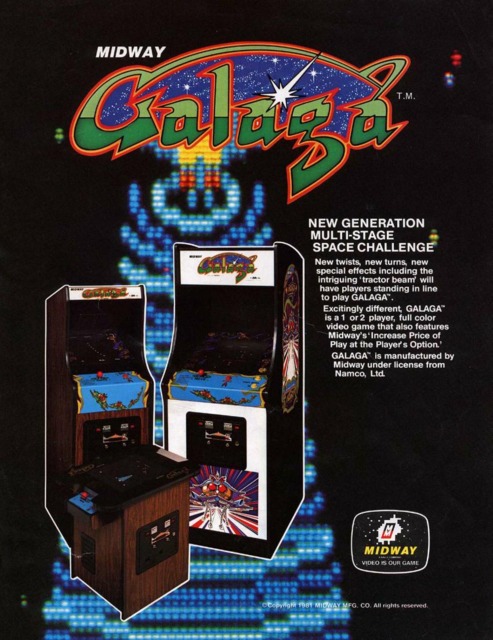The NES version of Galaga is a near-flawless port of the arcade.
In case you are unfamiliar, Galaga is a space shooter in which you control a ship at the bottom and blast away at oncoming enemies. Space Shooters exploded onto (and as a result totally rejuvenated) the arcade scene in the late 1970s with the arrival of the classic Space Invaders. Obviously, other game companies wanted to capitalize on Space Invader's success and quickly churned out clones, copies and variations of the immensely successful original. Galaga falls into the variation category and it's this variation that makes it such a hit. The enemies in Galaga first fly in and line up in standard Space Invaders formation, but once their attack starts it becomes clear that Galaga is a whole different beast. The enemies not only fire upon you but dive bomb at you while firing sometimes in predictable patterns and sometimes not. To the relief of many players, you are able to fire upon the enemies during their initial arrival and wipe out a good majority of them before they start their attack. After destroying all of the enemies you will then be taken to the next round which plays the same although the strength and vigor with which the enemy attacks increases with each successive level. An interesting play mechanic Galaga introduces is the ability to allow certain enemies to capture your ship. Once captured, your ship is held hostage until you destroy the enemy holding it. The ship is then returned to you and joins up with your existing ship to double your firepower! However, this venture is not risk free. If you accidentally shoot your ship while it is being held hostage, it will be destroyed like a regular enemy. Risking a life for double the firepower may not seem like a good choice, but most veteran players will tell you that the only way to play Galaga is with the extra firepower.
Every 3-5 levels, Galaga offers a fun "Challenging Stage" in which players attempt to blast 30/30 non-attacking enemies that fly around the screen in unusual formations. The player is rewarded with points for each enemy they destroy. A perfect 30/30 gets you additional bonus points. These challenging stages offer a nice break from the stress of a typical stage and add greatly to Galaga's charm.
Bandai was tapped by Namco (Galaga's original developer) to make the NES port of this arcade classic and they did an amazing job. For some reason, they subtitled the game "Demons of Death". However, that's simply window-dressing for the box. The core game remains unchanged. The game is near-identical graphically. The "triple enemy" that appears in some of the later levels do not look as arcade-perfect as the standard enemies, but they still look very close. There wasn't a ton of sound in the arcade version and what sound was there is faithfully reproduced on the NES. However, the single most important aspect of Galaga is its gameplay. Classic games didn't have the technology to sell on looks. They had to have fun gameplay to make money. The arcade version of Galaga offered an extraordinary amount of fun and precise fast-paced controls which makes it a blast (no pun intended) to play. I am thrilled to say that the NES version retained every ounce of gameplay and control found in the original! The single gameplay difference you’ll find is that the NES version allows you to start shooting the enemy about a second sooner than the arcade version when respawning after losing a life. This isn’t a huge deal, but purists will definitely notice and might complain about it even though it is to their advantage. My only other real gripe is that the NES version of Galaga doesn’t have a high score initials entry like the original. That’s disappointing when you put up a record score, but easily overlookable considering the technology you’re playing on.
When someone asks me what my all time favorite game is, I always say Galaga. Its simple premise, outstanding gameplay and perfect level of challenge will always make me stop and put in a quarter when encountering an arcade version. However, by purchasing Galaga: Demons of Death for the NES you can play this wonderful arcade classic as many times as you want without sacrificing any of the quality or any of your hard-earned quarters!
